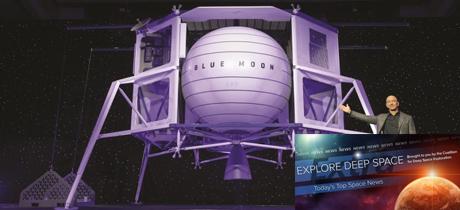In Today’s Deep Space Extra… Blue Origin, Lockheed Martin, Northrop Grumman and Draper Labs join forces to develop a commercial lunar lander for NASA’s Artemis initiative. ISRO investigating the loss of the Chandrayaan-2 Vikram lander. Vice President Pence says China will not be America’s space partner any time soon.
Human Space Exploration
Blue Origin, Lockheed, Northrop join forces for Artemis lunar lander
Coalition Members in the News – Lockheed Martin, Northrop Grumman
SpaceNews.com (10/22): Blue Origin on Tuesday announced plans to work with Lockheed Martin, Northrop Grumman and Draper Labs to develop a commercial lunar lander for NASA’s Artemis initiative. Their proposal will be submitted to NASA’s Human Landing Services Competition, which plans to select at least two lander concepts as it strives to reach the goal of an accelerated human landing at the Moon’s south pole in 2024. Blue will take the prime position and provide the descent vehicle, Lockheed the crew rated ascent stage and Northrop the transfer stage. Blue Origins founder Jeff Bezos made the announcement at the 70th International Astronautical Congress (IAC) underway this week in Washington. The commercial landers are to be operated from NASA’s lunar orbiting, human tended Gateway.
NASA Administrator invites public to update on agency’s return to Moon
NASA.gov (10/22): The public is invited to join NASA Administrator Jim Bridenstine at 9:40 a.m. EDT Friday, October 25, for an update on the agency’s Artemis program and the critical role international partnerships have in returning astronauts to the Moon and going on to Mars. The discussion, entitled “From the Moon to Mars: NASA’s Artemis Program,” will occur during Public Day at the 70th International Astronautical Conference (IAC).
NASA scientists eye long-standing Moon mysteries in lunar return
Space.com (10/22): NASA’s planned strategy for returning to the Moon with human explorers in 2024 could pay big science dividends. The lunar surface could offer a timeline for the violent impacts among solar system bodies during the early epoch of planet formation as well as when water ice and organics, building blocks for life, arrived, Jim Green, NASA’s chief scientist, told an opening day session of the 70th International Astronautical Congress (IAC) underway this week in Washington.
China is not going to be America’s space partner anytime soon (Op ed)
The Hill (10/22): From discussions this week at the International Astronautical Conference (IAC) in Washington, it seems clear that China is not on a course soon to become a partner nation in NASA led efforts to return to the lunar surface with human explorers in order to forge ahead to Mars and other deep space destinations. U.S. Vice President Mike Pence, chair of the White House National Space Council, pointed to differences in governance and, personal freedom and a lack of respect in China for property rights as obstacles.
Space Science
Chandrayaan-2: Vikram lander not found in new NASA images of Moon landing site
India Today (10/23): A second effort on October 14 by NASA’s Lunar Reconnaissance Orbiter (LRO) to spot the whereabouts of India’s Chandrayaan 2 Vikram lunar lander near the Moon’s south pole has come up empty. Contact was lost late September 6, U.S. time, as Vikram, with a small rover also on board, was attempting an automated landing for exploration during the lunar day. Vikram may be lost in shadow, or it may have landed outside the LRO’s field of view. The first attempt by LRO to spot Vikram was on September 17. The Indian Space Research Organization (ISRO) is investigating the loss.
Mars soil is very weird, the Mole’s struggles show
Space.com (10/22): NASA’s Mars Insight lander, which touched down at the Red Planet in late November, is offering some significant but perhaps surprising results. The lander’s Heat Flow and Physical Properties Package, an experiment to assess the flow of heat rising from the subsurface began to hammer its way into the soil in February with a goal of reaching a depth of 10 to 16 feet. But after reaching just a few inches in depth, progress stopped, either because a rock was blocking its progress or something to do with the soil. After troubleshooting, the difficulty was blamed on the soil qualities and the hammering resumed with a new approach.
Other News
Arianespace targets 2023 for lunar Ariane 6 rideshare mission
SpaceNews.com (10/22): The Arianespace Ariane 6 Moon ride share mission will serve as an entry for Europe into future lunar activity, company CEO Stéphane Israël said Tuesday, while speaking at the 70th International Astronautical Congress (IAC) in Washington D.C.
What happens when you leave empty seats at the table? (Op ed)
The Space Review (10/21): What happens as humans explore and develop space will have significant impacts, some risky, on the future of the human race, a premise that makes it all the more important the strategies are discussed with as much diversity as possible, writes astrobiologist and ethicist Monica Vidaurri, who consults for NASA’s Goddard Space Flight Center.

